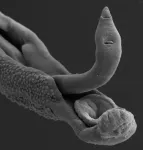(Press-News.org) SEATTLE – April 2, 2024 – Researchers from Fred Hutchinson Cancer Center, the American Cancer Society Cancer Action Network and peer institutions released new findings in the Journal of Clinical Oncology showing that when all types of cancer research studies are considered, at least one in five people with cancer, or 21.9%, participate in some form of clinical research.
The study evaluated all categories of cancer studies, such as treatment trials, biorepository studies and quality of life studies—the first time an estimate of participation in all types of cancer studies has been reported. Moreover, enrollment in cancer treatment trials was 7.1%, a notably higher participation rate than previous estimates of 2%-3%.
The study also found that enrollment in treatment trials was over five-fold higher at National Cancer Institute-designated cancer centers than at community sites (21.6% versus 4.1%), reflecting the impact that NCI funding for staff and infrastructure has on an institution’s ability to offer trials and recruit patients.
Using deidentified accreditation data provided by the Commission on Cancer, the study updated decades-old estimates for participation in cancer research. This expanded analysis includes more than 70% of people diagnosed with cancer in the U.S. each year who received care at a variety of clinical settings, from community hospitals and academic medical centers to NCI-designated comprehensive cancer centers. Additionally, the study reflects the broad spectrum of cancer research including different study types and those sponsored by industry, government and other sources.
“As we work to increase participation in cancer research studies and make them more accessible to patients, we need an inclusive, accurate assessment of current participation to inform these policies,” said Joseph Unger, PhD, MS, a health services researcher and biostatistician at Fred Hutch and lead author of the study. “While we knew that patients play a significant role in advancing all types of cancer research, now we better understand just how commonly people are participating in all types of cancer studies today.”
While previous estimates of participation in cancer research studies were derived solely from government-sponsored trials, the study authors used patient data from a diverse range of trial sponsors and care settings for this analysis. Importantly, the data included settings such as community hospitals, where a majority of U.S. cancer patients receive care.
“We know that most patients with cancer will participate in a clinical trial if given the chance, and the level of enrollment we see at NCI-designated cancer centers shows what participation can be when patients are offered trials,” stated Mark Fleury, PhD, a policy principle at ACS CAN and senior author of the study. “These findings emphasize the need to offer more patients in community settings the chance to participate and that will require an investment in these sites that currently isn’t there.”
People with cancer enrolled in many different types of clinical studies. The study found the following participation rates in each type of clinical study: biorepository (12.9%), treatment (7.1%), registry (7.3%), genetic (3.6%), quality-of-life (2.8%), diagnostic (2.5%) and economic studies (2.4%). Expanding the types of cancer clinical studies in this analysis demonstrates that there are a variety of ways people choose to participate in cancer research beyond the previous assessments, which were based only on participation in treatment studies.
“Cancer clinical research, in all of its forms, simply cannot be conducted without the contributions of people with cancer,” emphasized Dr. Unger. “These contributions are much more extensive than was previously recognized. Cancer clinical research is a true partnership between those with cancer and those who study and treat cancer.”
Dr. Unger reports the following disclosure: serves as a consultant for AstraZeneca and the American Cancer Society Cancer Action Network, which is unrelated to the current work.
# # #
Media Contact:
Claire Hudson
media@fredhutch.org
206-667-2210
Fred Hutchinson Cancer Center
Fred Hutchinson Cancer Center unites individualized care and advanced research to provide the latest cancer treatment options while accelerating discoveries that prevent, treat and cure cancer and infectious diseases worldwide.
Based in Seattle, Fred Hutch is an independent, nonprofit organization and the only National Cancer Institute-designated cancer center in Washington. We have earned a global reputation for our track record of discoveries in cancer, infectious disease and basic research, including important advances in bone marrow transplantation, immunotherapy, HIV/AIDS prevention and COVID-19 vaccines. Fred Hutch operates eight clinical care sites that provide medical oncology, infusion, radiation, proton therapy and related services. Fred Hutch also serves as UW Medicine’s cancer program.
END
Windows welcome light into interior spaces, but they also bring in unwanted heat. A new window coating blocks heat-generating ultraviolet and infrared light and lets through visible light, regardless of the sun’s angle. The coating can be incorporated onto existing windows or automobiles and can reduce air-conditioning cooling costs by more than one-third in hot climates.
“The angle between the sunshine and your window is always changing,” said Tengfei Luo, the Dorini Family Professor for Energy Studies at the University of Notre ...
Researchers in Brazil have used an innovative technique in molecular biology to identify targets for candidate vaccines against Schistosoma mansoni, the parasite that causes schistosomiasis.
Considered one of the world’s 17 neglected tropical diseases (NTDs), schistosomiasis affects some 200 million people in 74 countries, according to the World Health Organization (WHO). Six million are estimated to be infected in Brazil, mainly in the Northeast region and Minas Gerais state.
The scientists used phage display, the study of protein interactions using bacteriophages, viruses that infect bacteria, to screen 99.6% of 119,747 DNA sequences encoding the proteins known ...
UCalgary led study finds Netflix misses the mark by trivializing teenagers’ pain. Findings are published in PainResearchers at the University of Calgary and the University of Bath, U.K., are calling on Netflix to do a better job of representing the kind of pain typically experienced by 12-to-18-year-olds. A new study finds the streaming channel should not emphasize stereotypes, like the heroic, stoic boy and the helpless, emotional girl who requires his rescue and prioritizes his pain and suffering.
“Media ...
The Lundquist Institute for Biomedical Innovation at Harbor-UCLA Medical Center (TLI) today announced that The California Institute for Regenerative Medicine (CIRM), one of the world’s largest institutions dedicated to regenerative medicine, has
awarded $1.5 million to TLI Investigator Denise Al Alam, PhD, to support research that aims to understand lung disease in individuals with Trisomy 21 (also known as Down Syndrome). Although Trisomy 21 impacts multiple organ systems, respiratory complications are a significant cause of death in children and adults with this genetic condition.
With the highest occurrence of Down Syndrome births in California within the Latinx ...
Adolescents with high positive affect may have improved physical and mental health as adults, according to a study published April 2nd in the open-access journal PLOS Medicine by Eric Kim and Renae Wilkinson from Harvard University, US, and colleagues.
Positive affect is the experience of pleasurable emotions, such as happiness, joy, excitement, and calm. Research on adults has shown that positive affect is associated with healthier behaviors and decreased risk of chronic diseases, but data are limited in adolescents. Given that adolescence is a critical ...
Methods sections often lack critical details needed to reproduce an experiment, and the practice of citing previous papers instead of describing the methods in detail may contribute to this problem
Analysis of >750 papers shows that >90% of papers use at least one shortcut citation, that these significantly impair reconstruction of the original method, and that <25% of journals have policies relating to previously described methods
#####
In your coverage, please use this URL to provide access to the freely available paper in PLOS ...
LAWRENCE — With the evolution of artificial intelligence comes discussion of the technology's environmental impact. A new study has found that for the tasks of writing and illustrating, AI emits hundreds of times less carbon than humans performing the same tasks. That does not mean, however, that AI can or should replace human writers and illustrators, the study’s authors argue.
Andrew Torrance, Paul E. Wilson Distinguished Professor of Law at KU, is co-author of a study that compared established systems such as ChatGPT, Bloom AI, DALL-E2 and others completing writing and illustrating to that of humans.
Like ...
Media Alert: DENVER/April 2, 2024 — Morris Animal Foundation-funded researchers introduced a straightforward questionnaire to help horse owners identify and monitor signs of osteoarthritis pain in their equine companions. This initiative aims to facilitate earlier and more effective treatment, ultimately enhancing the quality of life for horses.
Created by Dr. Janny de Grauw, Senior Lecturer at The Royal Veterinary College in the United Kingdom, Bryony Lancaster, Program Director, MSc Equine Science of the University of Edinburgh and Dr. Diane Howard, the questionnaire is modeled after the Brief Pain Inventory used to evaluate pain severity and its impact ...
A pioneering study from the University of Florida has quantified corporations’ exposure to climate change risks like hurricanes, wildfires, and climate-related regulations and the extent to which climate risks are priced into their market valuations. The research also exposes a costly divide – companies that proactively manage climate risks fare much better than those that ignore the threats.
Using textual analysis of earnings call transcripts from almost 5,000 U.S. public companies, researchers developed novel measures of firms’ physical climate risk exposure ...
Scrub mints are among the most endangered plants you’ve probably never heard of. More than half of the 24 species currently known to exist are considered threatened or endangered at the state or federal level, and nearly all scrub mints grow in areas that are being rapidly developed or converted to agricultural pasture.
In a new study, researchers analyzed a distinct type of DNA marker, which shows there are likely more scrub mint species waiting to be scientifically described. And at least one species has been left without federal protection because of a technicality.
“The Titusville balm is currently considered ...






